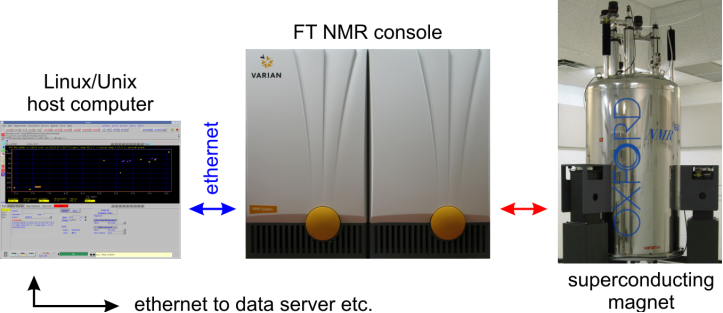3. NMR System Overview
Each spectrometer consists of three main components:
 |
Figure 3.1: The main components of an NMR spectrometer |
Aside from inserting and removing your sample the entire system is controlled nearly 100% from the spectrometer host computer.
3.1 Consoles, probes and other hardware
Spectrometer |
mr400 |
m400 |
i400 |
ibd5 |
u500 |
i600 |
v700 |
Console |
DD2 MR |
Mercury |
Inova |
Inova |
VNMRS |
VNMRS |
VNMRS |
Magnet Bore Size |
54mm |
54mm |
54mm |
51mm |
51mm |
51mm |
54mm |
No. Channels |
2 |
2 |
2 |
4 |
2 |
4 |
4 |
Probe |
onenmr |
4 nuc |
autoxdb |
autoxdb |
dual cold probe |
autoxid HCN probe |
HCN cold probe |
Tuning |
Protune |
No Tuning |
Protune |
Protune |
Protune |
Protune |
Protune |
Pulsed Field Gradient |
Y |
Y |
Y |
Y |
Y |
Y |
Y |
H1 S/N |
510:1 |
190:1 |
280:1 |
350:1 |
2200:1 |
1200:1 |
7000:1 |
C13 S/N |
175:1 |
155:1 |
180:1 |
250:1 |
1500:1 |
165:1 |
900:1 |
F19 S/N |
690:1 |
300:1 |
375:1 |
345:1 |
N |
N |
N |
P31 S/N |
180:1 |
76:1 |
190:1 |
155:1 |
N |
N |
N |
Li7, B11, Si29, Sn119, Plus Other Heteronuclei |
Y |
N |
Y |
Y |
N |
N |
N |
2D |
Y |
Y |
Y |
Y |
Y |
Y |
Y |
3D |
N |
N |
N |
Y |
N |
Y |
Y |
Temp. Control |
Y |
Y |
Y |
Y |
Y |
Y |
Y |
3.2 Sensitivity and spectral dispersion
H1 sensitivity and resulting experimental times or sample concentration, respectively, to reach the same signal-to-noise is compared below:
|
mr400 |
m400 |
i400 |
ibd5 |
u500 |
i600 |
v700 |
H1 sensitivity |
510:1 |
190:1 |
280:1 |
350:1 |
2200:1 |
1200:1 |
7000:1 |
expt. time to reach H1 s/n at a given sample concentration [min] |
8.4 |
60 |
28 |
18 |
0.44 |
1.5 |
0.04 |
sample concentration required to reach H1 s/n in a given time [mM] |
5.6 |
40 |
18.4 |
11.8 |
0.3 |
1 |
0.03 |
sweep width for 10 ppm H1 [Hz] |
4000 |
4000 |
4000 |
5000 |
5000 |
6000 |
7000 |
Spectral dispersion is proportional to the field strength hence a 600 is twice as good as a 300. The probability for spectral overlap in a two-dimensional experiment decreases significantly with increasing field strength:
300: 1.0 400: 0.56 500: 0.36 600: 0.25 700: 0.18